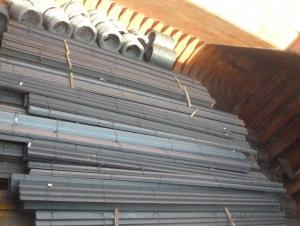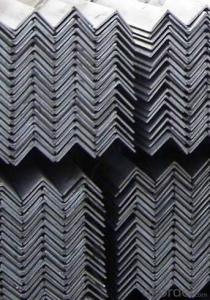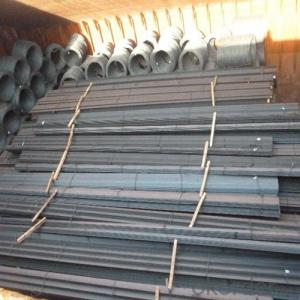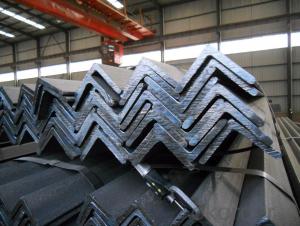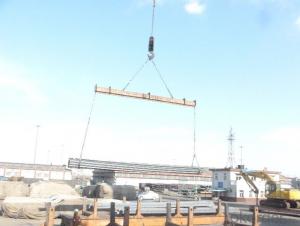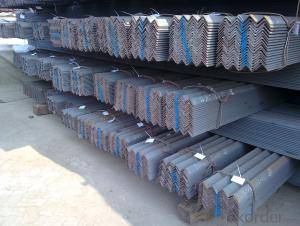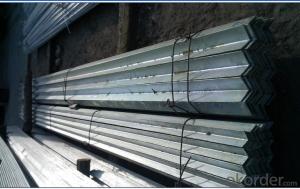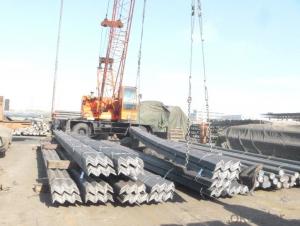GB ALLOY HOT ROLLED ANGLE STEEL 75*75 6M
- Loading Port:
- Qingdao
- Payment Terms:
- TT OR LC
- Min Order Qty:
- 50 m.t.
- Supply Capability:
- 10000 m.t./month
OKorder Service Pledge
OKorder Financial Service
You Might Also Like
Product Description:
Specifications of JIS SS400 Angle Steel
1.Standards:GB,ASTM,BS,AISI,DIN,JIS
2.Invoicing on theoretical weight or actual weight as customer request
3.Material: JIS G3192,SS400;SS540.
4. Payment terms:
1).100% irrevocable L/C at sight.
2).30% T/T prepaid and the balance against the copy of B/L.
3).30% T/T prepaid and the balance against L/C
5.Sizes:
EQUAL ANGLES SIZES |
| ||
a(mm) | a1(mm) | thickness(mm) | length |
25 | 25 | 2.5---3.0 | 6M/12M |
30 | 30 | 2.5---4.0 | 6M/12M |
38 | 38 | 2.5 | 6M/12M |
38 | 38 | 3.0---5.0 | 6M/12M |
40 | 40 | 3.0---6.0 | 6M/12M |
50 | 50 | 3 | 6M/12M |
50 | 50 | 3.7---6.0 | 6M/9M/12M |
60 | 60 | 5.0---6.0 | 6M/9M/12M |
63 | 63 | 6.0---8.0 | 6M/9M/12M |
65 | 65 | 5.0---8.0 | 6M/9M/12M |
70 | 70 | 6.0---7.0 | 6M/9M/12M |
75 | 75 | 5.0---10.0 | 6M/9M/12M |
80 | 80 | 6.0---10.0 | 6M/9M/12M |
90 | 90 | 6.0---10.0 | 6M/9M/12M |
100 | 100 | 6.0---12.0 | 6M/9M/12M |
120 | 120 | 8.0-12.0 | 6M/9M/12M |
125 | 125 | 8.0---12.0 | 6M/9M/12M |
130 | 130 | 9.0-12.0 | 6M/9M/12M |
140 | 140 | 10.0-16.0 | 6M/9M/12M |
150 | 150 | 10---15 | 6M/9M/12M |
160 | 160 | 10---16 | 6M/9M/12M |
180 | 180 | 12---18 | 6M/9M/12M |
200 | 200 | 14---20 | 6M/9M/12M |
5. Material Specifications:
Grade | Yield Strength,N/mm² | Extension Strength N/mm² | |||
Thickness of Steel,mm | |||||
≦16 | >16-≦40 | >40-≦100 | >100 | ||
SS330 | ≧205 | ≧195 | ≧175 | ≧165 | 330-430 |
SS400 | ≧245 | ≧235 | ≧215 | ≧205 | 400-510 |
SS490 | ≧285 | ≧275 | ≧255 | ≧245 | 490-610 |
SS540 | ≧400 | ≧390 | - | - | ≧540 |
Usage & Applications JIS SS400 Angle Steel
Trusses;
Transmission towers;
Telecommunication towers;
Bracing for general structures;
Stiffeners in structural use.
Packaging & Delivery of JIS SS400 Angle Steel
1. Transportation: the goods are delivered by truck from mill to loading port, the maximum quantity can be loaded is around 40MTs by each truck. If the order quantity cannot reach the full truck loaded, the transportation cost per ton will be little higher than full load.
2. With bundles and load in 20 feet/40 feet container, or by bulk cargo, also we could do as customer's request.
3. Marks:
Color mark: There will be color marking on both end of the bundle for the cargo delivered by bulk vessel. That makes it easily to distinguish at the destination port.
Tag mark: There will be tag mark tied up on the bundles. The information usually including supplier logo and name, product name, made in China, shipping marks and other information request by the customer.
If loading by container the marking is not needed, but we will prepare it as customer request.
Production flow of JIS SS400 Angle Steel
Material prepare (billet) —heat up—rough rolling—precision rolling—cooling—packing—storage and transportation
- Q: Are steel angles suitable for supporting rooftop equipment?
- Yes, steel angles are suitable for supporting rooftop equipment. Steel angles are commonly used in construction and engineering projects for their strength and durability. They provide a stable and secure support structure for rooftop equipment, such as HVAC units, solar panels, and communication antennas. Steel angles can be easily fabricated and installed to meet specific load requirements, making them an ideal choice for supporting heavy equipment on rooftops. Additionally, their corrosion resistance properties ensure long-term performance and minimal maintenance needs.
- Q: How do steel angles contribute to the seismic resilience of a structure?
- Steel angles play a vital role in bolstering a structure's ability to withstand seismic events. These angled steel components are commonly utilized in construction to reinforce strength and stability, particularly in areas prone to earthquakes. One manner in which steel angles contribute to the seismic resilience of a structure is by resisting lateral forces caused by seismic activity. During an earthquake, buildings face horizontal forces that can result in significant damage. Strategically placed steel angles within the structure help distribute and dissipate these forces, thereby reducing their impact on the overall building. By acting as braces or stiffeners, steel angles enhance structural integrity and prevent excessive deformation or collapse. Furthermore, steel angles are frequently employed in conjunction with other seismic design strategies like moment frames or shear walls. These elements work in tandem to create a robust and flexible structural system capable of withstanding the dynamic forces generated during an earthquake. Steel angles are typically integrated into these systems to provide additional reinforcement, thereby increasing overall strength and rigidity. In addition to their role in resisting lateral forces, steel angles also enhance a structure's seismic resilience by improving its load-carrying capacity. By more efficiently distributing loads, steel angles help reduce stress on individual components, preventing localized failures and ensuring overall stability. Moreover, steel angles possess excellent material properties, such as high tensile strength and toughness, making them highly durable. This durability enables them to withstand the dynamic loading and cyclic motions associated with earthquakes. Additionally, steel angles are resistant to corrosion, a crucial aspect for maintaining long-term structural integrity and overall performance during seismic events. In conclusion, steel angles are essential in enhancing a structure's ability to withstand seismic events. By resisting lateral forces, improving load-carrying capacity, and providing durability, they contribute to the stability and integrity of the building. Incorporating steel angles into the design and construction process is crucial for creating structures capable of withstanding seismic activities and ensuring the safety of occupants.
- Q: What is the difference between equal and unequal steel angles?
- Structural steel components commonly used in construction and industrial applications include equal and unequal steel angles. The dimensions and properties of these angles are what set them apart. Equal steel angles, also known as L-shaped angles, have sides and angles that are the same. They are frequently employed to provide support and stability in various structures like buildings, bridges, and machinery. The symmetrical load distribution and balanced strength in all directions make them perfect for applications requiring equal support on both sides. In contrast, unequal steel angles have sides and angles that differ. These angles are used when there is a need for uneven load distribution or a specific angle for a particular job. The longer side of the angle typically carries the load, while the shorter side can provide additional support or serve as a connection point. Unequal angles are commonly used in constructing frames, brackets, and supports where uneven load distribution is expected. Both equal and unequal steel angles are made from carbon steel, which offers good strength and durability. They can be either hot-rolled or cold-formed, depending on the manufacturing process. Hot-rolled angles are produced at high temperatures, resulting in a rough surface finish but improved mechanical properties. On the other hand, cold-formed angles are shaped and bent at room temperature, resulting in a smoother surface finish but slightly lower mechanical properties. In conclusion, the main distinction between equal and unequal steel angles lies in their dimensions and load distribution abilities. Equal angles have identical sides and are used for symmetrical load distribution, while unequal angles have different side lengths and are used for uneven load distribution or specific angle requirements. Both types of angles are made from carbon steel and find common usage in construction and industrial applications.
- Q: How do you join two steel angles together?
- To join two steel angles together, there are several methods you can use depending on the specific application and requirements. Here are a few common techniques: 1. Welding: Welding is the most common method used to join steel angles. It involves heating the joint to a high temperature and melting a filler material, usually a compatible metal, to fuse the two angles together. This creates a strong and permanent bond. Welding requires specialized equipment and expertise, so it is typically done by trained professionals. 2. Bolting: Another method is to use bolts or screws to connect the two steel angles. This involves drilling holes through both angles and then securing them with appropriate fasteners. Bolting allows for easier disassembly and modification if needed. However, it may not provide the same level of strength as welding. 3. Riveting: Riveting is a technique that uses metal pins or bolts called rivets to hold the steel angles together. It involves drilling holes through the angles and inserting the rivets, which are then hammered or pressed to form a permanent joint. Riveting is commonly used in structural applications where high strength and load-bearing capacity are required. 4. Adhesive bonding: In some cases, adhesive bonding can be used to join steel angles. Specialized adhesives are applied to the joint surfaces, and then the angles are pressed together and left to cure. This method can provide a clean and aesthetically pleasing bond, but it may not be as strong as other mechanical methods. When selecting a method to join steel angles, it is important to consider factors such as the load-bearing requirements, structural integrity, accessibility, and the specific conditions of the application. Consulting with a structural engineer or a professional in the field can help determine the most suitable technique for your specific needs.
- Q: What are the limitations of using steel angles in corrosive or saltwater environments?
- The use of steel angles in corrosive or saltwater environments is limited due to their susceptibility to corrosion. Steel is primarily composed of iron, which can react with oxygen and water to form iron oxide, commonly known as rust. In the presence of corrosive substances or saltwater, this corrosion process is accelerated. One limitation is the potential for accelerated corrosion in these environments. Corrosion weakens the structural integrity of the steel angles, which can compromise the overall stability and safety of any structure they are used in. This can be particularly concerning in applications where the steel angles are load-bearing or subjected to significant stress. Another limitation is the decrease in the lifespan of steel angles in corrosive or saltwater environments. The ongoing corrosion process can significantly reduce the lifespan of the steel angles, leading to more frequent maintenance or replacement requirements. This can result in higher costs and potential disruptions to operations or projects. Furthermore, the appearance of the steel angles can be negatively affected by corrosion in corrosive or saltwater environments. Rust stains can develop on the surface of the steel, which can be aesthetically unappealing, especially in applications where the steel angles are visible. To overcome these limitations, alternative materials can be considered for corrosive or saltwater environments. Stainless steel, for example, contains a high proportion of chromium, which provides it with enhanced corrosion resistance. Additionally, protective coatings or treatments, such as galvanizing or epoxy coatings, can be applied to steel angles to provide an additional barrier against corrosion. Overall, while steel angles are versatile and widely used in various applications, their use in corrosive or saltwater environments is limited due to their susceptibility to corrosion. It is crucial to carefully evaluate the specific environment and consider alternative materials or protective measures to ensure the longevity and integrity of any structure or project.
- Q: Can steel angles be used for support structures in telecommunications installations?
- Yes, steel angles can be used for support structures in telecommunications installations. Steel angles are commonly used in construction and engineering applications due to their strength and durability. They provide excellent support and can withstand heavy loads and harsh environmental conditions. In telecommunications installations, steel angles are often used for mounting antennas, satellite dishes, and other equipment. They offer a stable and secure platform for the installation of telecommunications infrastructure, ensuring reliable and efficient communication networks. Additionally, steel angles can be easily customized and fabricated to meet specific design requirements, making them a versatile choice for support structures in telecommunications installations.
- Q: How do you specify steel angles in a construction project?
- In a construction project, steel angles are specified based on their dimensions, grade, and any additional requirements. The dimensions of a steel angle are typically specified as the length of each leg and the thickness of the material. For example, a common specification might be "2-inch by 2-inch by 1/4-inch steel angle". The grade of steel angle is also important to specify as it determines the strength and durability of the material. Common grades for steel angles include A36, A572, and A588. The specific grade chosen will depend on the structural requirements and environmental conditions of the project. In addition to dimensions and grade, any additional requirements such as corrosion resistance, fire resistance, or special finishes should also be specified. For example, if the steel angles will be exposed to outdoor elements, they may need to be hot-dip galvanized or coated with a protective paint. It is important to consult relevant codes and standards, such as the American Institute of Steel Construction (AISC) manual, for guidance on specifying steel angles in a construction project. These codes provide guidelines on allowable stress, design criteria, and other factors to ensure the safe and efficient use of steel angles in structural applications.
- Q: Can steel angles be drilled or cut?
- Yes, steel angles can be drilled or cut. Steel angles are a versatile structural material that is commonly used in various construction and manufacturing projects. They can be easily drilled to create holes for bolts, screws, or other fasteners. Additionally, steel angles can be cut to specific lengths or shapes using tools such as saws, plasma cutters, or shears. The ability to drill or cut steel angles makes them highly adaptable and suitable for a wide range of applications.
- Q: What are the most common sizes of steel angles?
- Steel angles are commonly found in sizes ranging from 1/2 inch to 6 inches wide, with thicknesses varying from 1/8 inch to 1/2 inch. These sizes are readily accessible in the market and widely utilized in construction and industrial sectors. It is worth mentioning that certain projects or industries might necessitate custom sizes or larger dimensions to meet specific structural needs.
- Q: Are steel angles corrosion resistant?
- Steel angles, unless specially designed and treated, are generally prone to corrosion. They are typically made from carbon steel, which can corrode when exposed to moisture, oxygen, and other corrosive substances. Nevertheless, stainless steel angles, enhanced with chromium and other alloying elements, offer greater resistance to corrosion. These stainless steel angles are commonly employed in corrosive environments like marine or industrial settings. To evaluate the corrosion resistance of a steel angle, one must carefully consider its specific type and grade.
Send your message to us
GB ALLOY HOT ROLLED ANGLE STEEL 75*75 6M
- Loading Port:
- Qingdao
- Payment Terms:
- TT OR LC
- Min Order Qty:
- 50 m.t.
- Supply Capability:
- 10000 m.t./month
OKorder Service Pledge
OKorder Financial Service
Similar products
Hot products
Hot Searches
Related keywords
